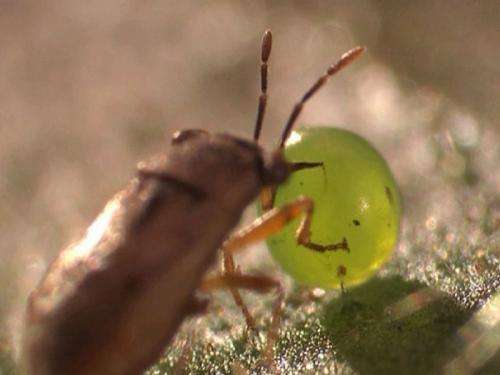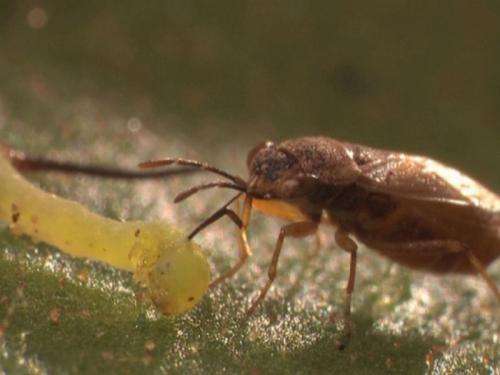Green leaf volatiles increase plant fitness via biocontrol

To solve the acute, global problem of securing food resources for a continuously growing population, we must work constantly to increase the sustainability and effectiveness of modern agricultural techniques. These efforts depend on new insights from plant ecology, particularly from work on native plants that grow in the primordial agricultural niche. Based on field studies on wild tobacco plants in the Great Basin Desert, Utah, USA, researchers of the Max Planck Institute for Chemical Ecology in Jena, Germany, demonstrated that the release of volatiles which attract enemies of herbivores not only controls insect pests, but also increases the reproduction of infested plants. Transferred to the goals of integrated pest management, this means that these natural plant defences can be utilized to improve and increase agricultural yields in an environmentally friendly manner. These results are published on October 15, 2012, as part of the launch of the new open-access journal eLife.
For three decades, ecologists have observed that plants emit specific volatiles after herbivory, causing a striking effect: they can reduce the number of insect attackers on a plant by up to 90 percent, because herbivores' enemies can recognize such volatiles as a "call to dinner". Typical examples are the attraction of parasitic wasps or predatory bugs after leaves have been attacked by moth larvae, or the underground "cry for help" emitted by maize roots to attract nematodes feeding on corn rootworm larvae. However, until now, one important question for farmers remained unanswered: Does the so-called indirect defence reaction of a plant positively influence the plant's fitness, its vegetative and especially reproductive growth, the generation of flowers and seeds: its ability to produce grandchildren? For this cannot be taken for granted. Defence reactions, such as the emission of odour molecules or the synthesis of digestive inhibitory substances, are costly and may attract foes as well as friends, or squander resources needed for seed maturation. After defending itself, a plant may survive, but at what cost? Is it really better off than if it had simply tolerated the herbivorous foe? Natural defences, or in other words biological control, are only useful for agriculture if they secure or, better, increase expected yield.

With only very few exceptions, plants emit green leaf volatiles (GLVs) when damaged. The GLVs released by damaged wild tobacco attract Geocoris bugs which attack herbivores, most importantly young herbivorous Manduca larvae: each Manduca larva, if allowed to grow to full size, can consume multiple full-grown wild tobacco plants! The emission of specific GLVs, including (E)-2-hexenal and related compounds, increases as soon as freshly hatched Manduca larvae start feeding on leaves – and so Geocoris can tell whether the GLVs come from Manduca feeding as opposed to any other damage. In contrast, proteinase inhibitors (PIs) are synthesized in the leaves to interfere with the digestion of leaf proteins and thus render the plant less nutritious to herbivores; hence, they can weaken feeding caterpillars. Both GLVs and PIs have been shown to reduce the number of particular herbivores, or the amount of damage they cause, for plants growing in nature over the course of short field trials. This time, researchers asked the question: do these compounds increase yield, i.e. reproduction, over the full growing season of a plant? In other words, are plants which produce these compounds really fitter than those that don't?
In the summers of 2010 and 2011, Meredith Schuman, Kathleen Barthel and Ian Baldwin performed field experiments with transgenic GLV-deficient and PI-deficient wild tobacco plants in the plants' native habitat, Utah, USA. They were able to demonstrate that GLV emission not only reduced the number of Manduca caterpillars and eggs on plants, but also increased flower and bud production of plants attacked by Manduca. On the other hand, no significant correlation between the formation of PIs and an increase in the number of buds or flowers was found. However, the scientists hypothesized that PIs might still weaken the caterpillars; as a consequence, the malnourished larvae might be less able to fight back against predators. This in turn could have an indirect, positive effect on flower production.
Bio-organic farming is an agricultural approach which uses biological pest control as an alternative to toxic synthetic insecticides, for example employing parasitic wasps against the dangerous larvae of the European corn borer. The results described here show that GLVs might be used to increase the effectiveness of such biological control. Like farmers using parasitic wasps, wild tobacco plants "use" Geocoris predators, attracting them with GLVs to predate Manduca herbivores. GLVs have been shown to attract other predators and parasitoids, and are emitted by all crop plants studied. "Such 'indirect' pest control may also help to avoid the common problem of pests developing resistance to toxic pesticides", says Ian Baldwin from the Max Planck Institute for Chemical Ecology.
More information: Meredith C. Schuman, Kathleen Barthel, Ian T. Baldwin (2012). Herbivory-induced volatiles function as defences increasing fitness of the native plant Nicotiana attenuata in nature, eLife, DOI: 10.7554/elife.00007
Journal information: eLife
Provided by Max Planck Society


















